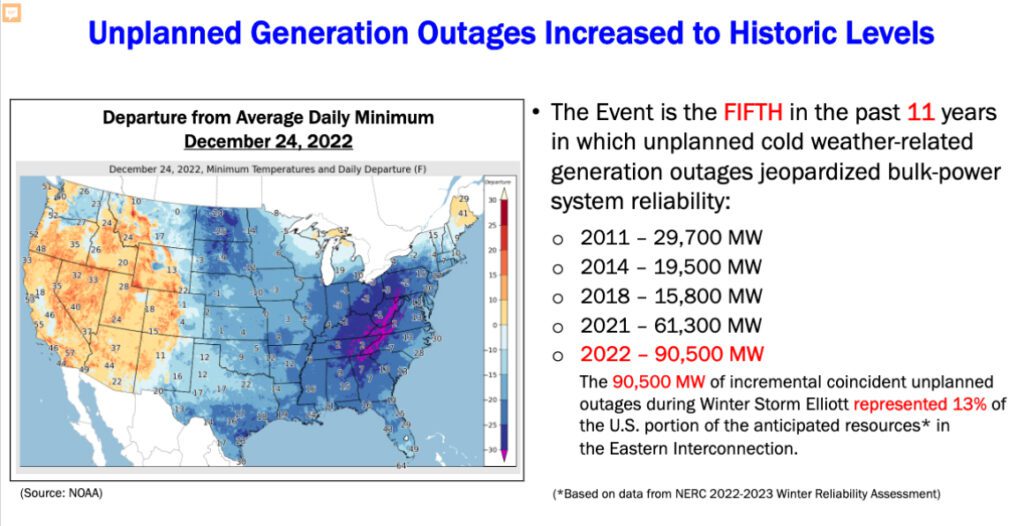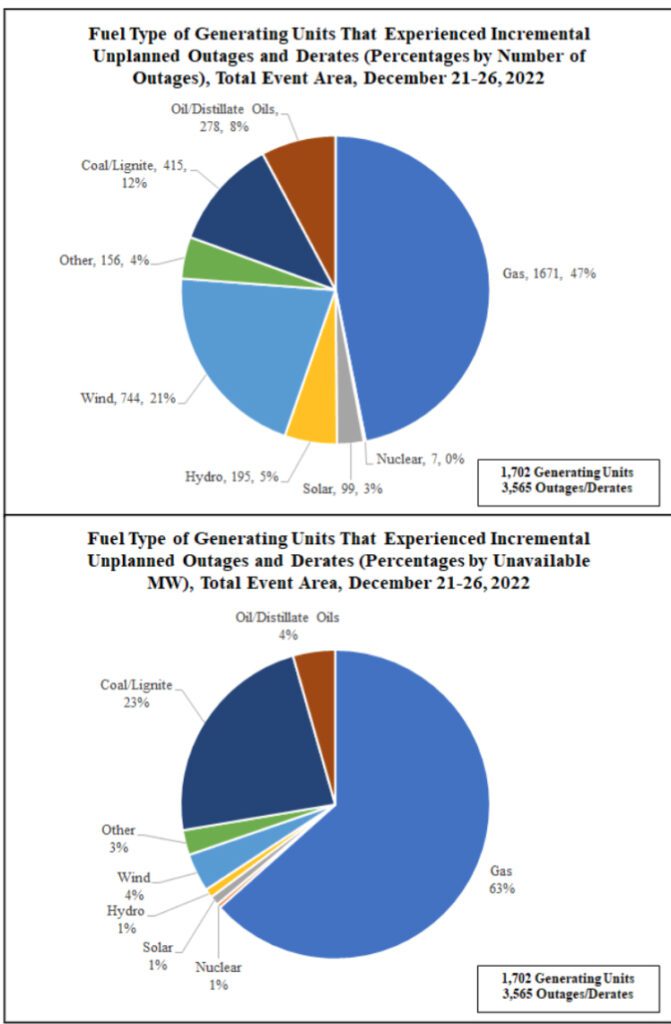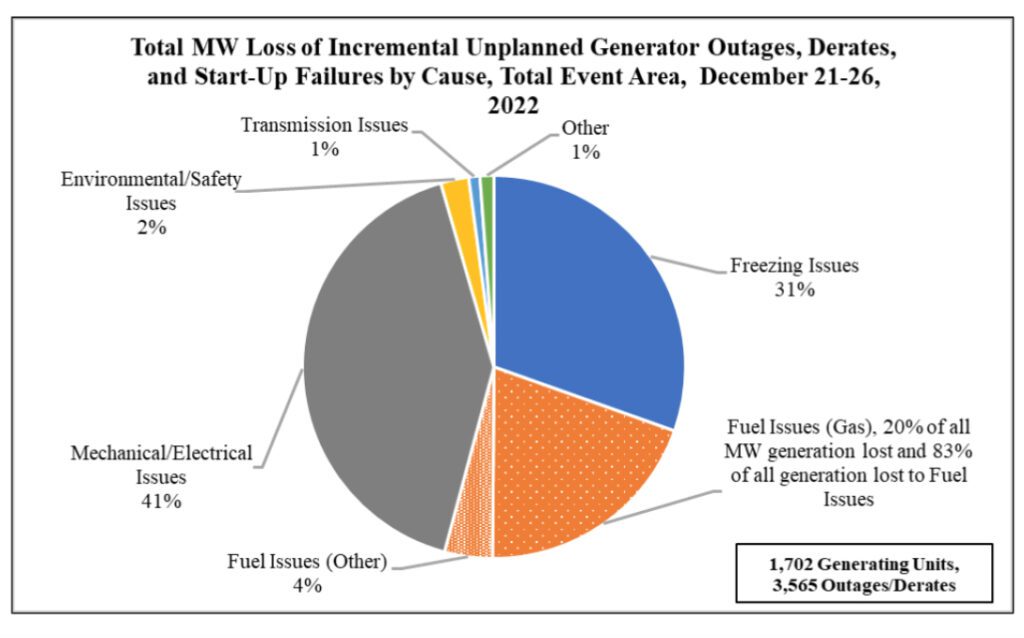FERC, NERC Reveal Disturbing Details from Winter Storm Elliott Inquiry
Incremental unplanned generation outages triggered during Winter Storm Elliott spiked to 90.5 GW—significantly more than the 61.8 GW during Winter Storm Uri in 2021—representing 13% of the U.S. portion of anticipated resources in the Eastern Interconnection.
That finding, one of many disturbing details unveiled by the Federal Energy Regulatory Commission (FERC) and North American Electric Reliability Corporation (NERC) as part of their joint inquiry into the devastating December 2022 winter storm, points to an urgent need for cold weather reliability standard revisions for power and gas systems, the entities suggested on Sept. 21. While the final report delving deeper into the event is scheduled to be published in full this fall, a presentation on Thursday by FERC and NERC staff, along with staff from NERC’s six regional entities, sought to unravel the complexities of the storm’s impact.
It suggests that the storm’s worst conditions on Dec. 23 to 24, 2022, struck as winter loads peaked and unplanned generation outages soared to historic levels. Unplanned generation outages during Winter Storm Elliot—now the U.S.’s fifth reliability-roiling winter storm in the past 11 years—were nearly 40% higher than during Winter Storm Uri, the February 2021 freeze that triggered the loss of 68.1 GW of generation in the Electric Reliability Council of Texas (ERCOT), Southwest Power Pool (SPP), and the Midcontinent Independent System Operator (MISO).

90.5 GW of Incremental Co-incident Unplanned Generation Outages
Combined, during Winter Storm Elliot, 1,702 individual generating units experienced 3,565 outages, derates, or failures to start. Of these, 825 units—nearly half— were natural gas-fired generators.

FERC and NERC said 55% of generating unit outages, derates, and failures to start were primarily caused by freezing and fuel issues. While an estimated 41% of these events are attributed to mechanical or electrical issues, the joint inquiry team “found them to be correlated with subfreezing temperatures.” Another key finding staff highlighted is that generators that had mechanical/electrical issues “increased with decreasing ambient temperatures.”
Meanwhile, of generators that suffered “freezing issues,” nearly 80% occurred at ambient temperatures that were above their documented minimum operating temperatures. Put in a starker way, that means that “nearly 80% of the generating units failed to perform at temperatures above their own documented minimum operating temperatures,” FERC and NERC underscored.

The conditions prompted several balancing authorities (BAs) across the Eastern U.S. to declare energy emergencies, and some, to shed load. In total, 5 GW of firm load was shed during different times. The Tennessee Valley Authority (TVA) BA bore the brunt of the crisis, enduring nearly eight hours of load shedding, 3 GW at its worst point. Duke Energy Carolinas (DEC) and Duke Energy Progress (DEP) BAs shed a combined three hours of load, a total 1.9 GW at their worst points. Louisville Gas and Electric–Kentucky Utilities (LGE-KU) BA weathered roughly four hours of load shedding and at its worst point, 300 MW.
In the southeastern U.S., Dominion Energy South Carolina (DESC) and South Carolina Public Service Administration/Santee Cooper (SC PSA) BAs experienced short-lived but impactful load-shedding events of 94 MW and 86 MW, respectively. While these impacts prompted PJM, Southern, MISO, SPP, and ISO-NE to declare energy emergencies, the entities were spared from firm load shedding.
A Glaring Gas Supply Crisis
The presentation also reveals that the crippling extreme cold weather event played out as dry natural gas production in the lower 48 states dropped to a low of 82.5 billion cubic feet (Bcf) on Dec. 24—a 16% decrease (16.1 Bcf) compared to Dec. 21. Natural gas production infrastructure suffered wellhead freeze-offs and equipment freezing, as well as poor road conditions. Processing facilities also suffered disruptions, outages, and operating issues, which affected production volumes. These were exacerbated by freezing and mechanical issues, staff said. Freezing and mechanical issues on pipeline infrastructure also caused issues.
In a statement on Thursday, FERC and NERC underscored that natural gas pipeline pressures “dropped largely because of freeze-related production declines in production of Marcellus (23%) and Utica (54%) shales, as well as other natural gas infrastructure freeze- and equipment-related problems. Every cold-weather inquiry report that has studied natural gas production has found cold-related declines in natural gas production, by as much as 70% in some cases.” Meanwhile, Consolidated Edison, which serves the greater New York Metropolitan area, “faced reliability-threatening low pressures on its delivery pipelines, forcing it to declare an emergency and use its own liquefied natural gas facility to maintain service,” they noted.
Those disruptions were debilitating to the power system. The presentation says that 63 natural gas power unit outages or derates—a stunning 10 GW—were “due to firm gas transportation curtailments during the event.”
But, at the same time, higher transmission flows resulted in constraints, though many were mitigated by grid operator actions. PJM, for example, curtailed a power transfer to TVA to resolve a real-time constraint on Dec. 23. MISO declared two local transmission emergencies (LTEs), one to access additional hydropower capacity.
A ‘Sobering’ Report That Demands Action
A key setback may have been that most BAs “underestimated” load on Dec. 23 and Dec. 24, 2022. “One BA’s underestimation was as much as 11.6% for their ‘day-ahead’ forecast for Dec. 23,” the presentation notes. “Two BAs’ underestimations were as much as 5% for their ‘day-ahead’ forecasts for Dec. 24.”
Most of these issues echo challenges that were present during past cold weather events, FERC and NERC said. In a statement, NERC President and CEO Jim Robb called the report “sobering.” It “underscores the need to take urgent action on the interdependence between the bulk electric and natural gas systems, including the need for sufficient and reliable gas and electric infrastructure to sustain energy reliability,” he said.
FERC and NERC recommended 11 immediate actions. “The report states there must be robust monitoring of how the industry is implementing current cold weather Reliability Standards to determine if reliability gaps exist. Also, NERC should obtain an independent technical review of the causes of cold-related mechanical and electrical generation outages to identify preventive measures, which includes determining if additional reliability standards are needed,” they added.
In addition, the report suggests Congress and state legislators or regulators must establish reliability rules for natural gas infrastructure to ensure cold weather reliability. “Currently, no regulatory entity is tasked with ensuring the reliability of the natural gas infrastructure on which the electric grid relies,” FERC and NERC noted.
To resolve long-standing gas and electric interdependency challenges, the report recommends that the North American Energy Standards Board [NAESB] convene a meeting of gas and electric grid operators and gas distribution companies to identify improvements in communication during extreme cold weather events. (NAESB, notably, in July 2023 issued a significant report outlining solutions to address “systemic weaknesses” in the natural gas and electric network nexus.) That could “enhance awareness across the natural gas supply chain,” FERC and NERC said. “In addition, the report suggests hiring an independent research group to analyze whether additional gas infrastructure is needed to support grid reliability and meet the needs of gas utilities.”
“NERC, the regional entities, and FERC are fully committed to finding effective, collaborative solutions in line with these findings,” Robb said. “The report also reaffirms NERC’s equally strong commitment to completing Reliability Standards work to ensure industry is prepared for extreme cold weather.”
FERC Chairman Willie Phillips in a statement also underscored urgent action. “It’s abundantly clear that we must make major improvements to the cold-weather reliability of both the natural gas and electricity production and grid systems,” he said. “I have said repeatedly: Someone—it doesn’t have to be FERC—must have authority to establish and enforce natural gas reliability standards. And some recommendations from the 2021 Uri report are still not implemented.”
Phillips pleaded: “Please get that done. It shouldn’t take five winter storms in 11 years to show us the gravity of the situation we find ourselves in.”
—Sonal Patel is a POWER senior associate editor (@sonalcpatel, @POWERmagazine).